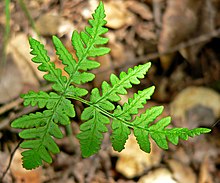| Pentagramma triangularis | |
|---|---|

| |
|
Scientific classification
| |
| Kingdom: | Plantae |
| Clade: | Tracheophytes |
| Division: | Polypodiophyta |
| Class: | Polypodiopsida |
| Order: | Polypodiales |
| Family: | Pteridaceae |
| Subfamily: | Cheilanthoideae |
| Genus: | Pentagramma |
| Species: | P. triangularis
|
| Binomial name | |
| Pentagramma triangularis (Kaulf.) Yatsk., Windham & E. Wollenw.
| |
| Synonyms [1] | |
| |
Pentagramma triangularis, commonly known as the gold fern or the goldback fern, is a species of fern in the family Pteridaceae, native to Western North America, with highest abundance in the state of California. [2] Its common name "goldback" refers to the light yellow color of the fern's protective coating which inhibits moisture loss. The gold texture appears as a dry powder that is excreted on the underside of the fern. [3] The Latin specific epithet Pentagramma derives from "five lines" or "stripes" while triangularis derives from "three sided", describing the shape of the fern's broad triangular fronds. [3]
Description
Like all ferns, P. triangularis does not produce flowers nor seeds, only spores. It has long smooth petioles (frond stems) that are anywhere from black to brown in color, and its fronds are bright to dark green on top with dark spore sacs ( sporangia) on the leaf bottom surrounded by a lighter yellow excreted powdery substance. [3]
P. triangularis can grow to a height of 6 to 12 inches. [4] [3] In common with other Pentagramma species, the basal pinna has a characteristic asymmetry, with the basal secondary pinna on one side much (2 to 6-fold) longer than on the other. In response to dry conditions, the leaves curl up with the lower (spore) side outward, presumably to conserve water.

Subspecies
- P. triangularis subsp. semipallida (J. Howell) G. Yatsk. et al. – pale gold back fern [5]
- P. triangularis subsp. triangularis
Some taxa formerly considered subspecies of P. triangularis have been raised to species rank in Pentagramma.
- Pentagramma maxonii, previously P. triangularis subsp. maxonii [6]
- Pentagramma viscosa, previously P. triangularis subsp. viscosa [7]
Distribution
The distribution of P. triangularis includes much of the west coast of North America and extends from Vancouver Island, British Columbia, to Baja California, Mexico, east to Arizona, and in the Blue Mountains of south eastern Washington. [8] This species is also found on the Pacific island of Guadalupe off the Baja California shore, and plants there may represent an undescribed taxon. [9]
Habitat
In California P. triangularis prefers shaded areas and is commonly found in rocky crevices and on north-facing slopes, in mixed evergreen and oak forests, and occasionally on dry brushy slopes. [10] [3] In more northerly locations, such as British Columbia and Washington State west of the Cascade Range, it may be found in part shade or full sun mostly on rocky outcrops. [8] It is found at elevations between sea level and 8,500 ft (2591 m). [10] [8]
Uses
The fronds are eaten by species such as the Dusky-footed woodrat. [3]
The Indigenous tribes of California would use the goldback fern as an analgesic treatment. The Karuk tribe would use the fern to treat pain related to childbirth, and the Miwok tribe would use the fern as a treatment for toothaches. Additionally, Yurok tribe children would use the fern to create body art with the golden powder. [4]
References
- ^ "Hemionitis triangularis (Kaulf.) Christenh". Plants of the World Online. Royal Botanic Gardens, Kew. Retrieved 2020-01-05.
- ^ Calflora . accessed 2.12.2013
- ^ a b c d e f "Goldback Fern". friendsofedgewood.org. Retrieved 2021-11-13.
- ^ a b "Goldback Fern (Pentagramma triangularis ssp. triangularis) | Curbstone Valley". curbstonevalley.com. Retrieved 2021-11-13.
- ^ Calflora: Pentagramma triangularis ssp. semipallida
- ^ "Pentagramma triangularis subsp. maxonii in Flora of North America @ efloras.org". www.efloras.org. Retrieved 2021-11-13.
- ^ "Pentagramma triangularis subsp. viscosa in Flora of North America @ efloras.org". www.efloras.org. Retrieved 2021-11-13.
- ^ a b c "Burke Herbarium Image Collection". biology.burke.washington.edu. Retrieved 2021-11-13.
- ^ Rebman, J. P.; Gibson, J.; Rich, K. (2016). "Annotated checklist of the vascular plants of Baja California, Mexico" (PDF). San Diego Society of Natural History. 45: 22.
- ^ a b "SEINet Portal Network - Pentagramma triangularis". swbiodiversity.org. Retrieved 2021-11-13.
External links
- Calflora database: Pentagramma triangularis
- USDA Plants Profile for Pentagramma triangularis (goldback fern)
- Jepson Manual Treatment for Pentagramma triangularis
- Pentagramma triangularis — UC Photo gallery
- Pteridaceae
- Ferns of California
- Ferns of Mexico
- Ferns of the United States
- Flora of the Northwestern United States
- Flora of the Southwestern United States
- Flora of British Columbia
- Flora of New Mexico
- Flora of the Cascade Range
- Flora of the Klamath Mountains
- Flora of the Sierra Nevada (United States)
- Flora of the California desert regions
- Flora of Mexican Pacific Islands
- Natural history of the California chaparral and woodlands
- Natural history of the California Coast Ranges
- Natural history of the Mojave Desert
- Natural history of the Peninsular Ranges
- Natural history of the San Francisco Bay Area
- Natural history of the Santa Monica Mountains
- Natural history of the Transverse Ranges
- Ferns of the Americas